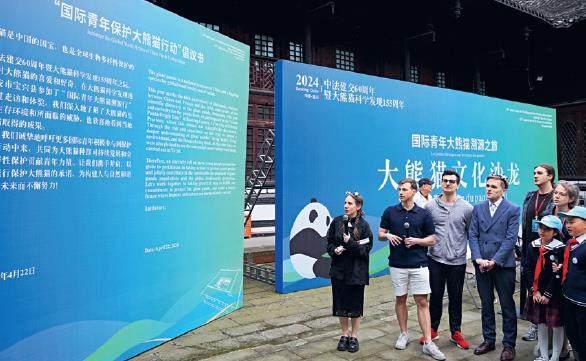Lessons from Baoxing
ZACHARY G. LUNDQUIST



A group of international youth and Chinese officialsgather in Baoxing, hometown of China's giant panda,to celebrate the China-France friendship and protectionof wildlife.
N the heart of Sichuan Province in southwestChina lies a small county not many peopleknow about, though the fluffy animals firstdiscovered there scientifically are universallyknown and adored. Baoxing in Yaan City is betterknown as the hometown of Chinas giant pandasand today, it has also become a biodiversityhotspot and type locality for many endangeredspecies.
The region has witnessed Chinas journey in discovering, appreciating, and protecting wildlife.On April 22, a group of foreigners togetherwith Chinese scholars, government officials, andpanda lovers gathered in Baoxing to celebrate the155th year of the scientific discovery of the giantpanda and the 60th anniversary of the establishmentof diplomatic relations between China andFrance. The giant panda origin tracing tour includedthe inauguration of the Giant Panda InternationalCulture Exchange Center in Baoxing anda series of activities at the Panda InternationalOriginal Discovery Camp, including a tour of thesite where a French zoologist recorded the giantpanda 155 years ago, the first Westerner to do so.There was also a dialogue between Chinese scholarsand international young people, and a visit tothe four pandas living in the camp area.
During an age of challenging political changes across the world, hegemony of political parties,and conflicts between political systems, whatinspiration can the story of the discovery of giantpanda give us today?
Inspiring Love for Nature
The public attention given to the giant panda,especially in Western countries, dates back to themid 19th century when French missionary-zoologistArmand David recorded for the first time scientificdetails about the species in 1869. Duringthe 12 years that David lived in China, he discovered189 new species of animals and plants andsent dozens of specimens back to Paris whichwere previously unknown. On March 11, 1869, hemade the following entry in his journal, “…when Iwas on my way back to the church, I was invitedto have a rest in a Mr. Lis home. In his home, Isaw the pandas skin. Its big and beautiful, coloredblack and white. The skin was quite peculiar.Li told me that I would see this animal very soon,for his hunters were going to hunt this animal …it seemed that a new species in the science domainwill be found.”
From an animal hunted for its pelt to a nationaltreasure of China that is loved around theworld, the fate of pandas has greatly improved.Because of the steps David took to analyze, record,and then publicize his discoveries we canenjoy looking at them even today. Though theinitial popularity of the panda triggered attemptsby other nations to capture the animals and raisethem in captivity, thanks to the steps taken bythe Chinese government to protect wildlife, thegiant panda was rescued from the verge ofextinction.
“For a long time, I have had two dreams ofthings I wanted to do while in China: one was tovisit the Great Wall of China and the other was tosee the giant panda,” a masters student namedAna Maria Crivat from Romania said in the afternoondialogue on April 22. “Today, I can happilysay both of those dreams have come true. And Iwill show pictures of the giant panda to my familyback at home.” This interest in the giant panda— a symbol of China and wildlife conservancy —and desire to share what China has done to pro-tect the giant panda was shared by all present inthe dialogue.
Promoting Nature Conservancy
Between 1869 and 2023, 165 nature reserveshave been established in Sichuan, covering over aquarter of the size of the province. Many of themare exclusively for the giant panda. In May of1950 Chinas State Council announced a ban onhunting giant pandas. Chinas first national giantpanda survey conducted from 1974 to 1977 found2,459 pandas in the wild, but the second surveyfrom 1985 to 1988 found their number had halvedto just 1,114. In 2008 the International Union forConservation of Nature (IUCN) classified the giantpanda as “endangered” and put it on its RedList of Threatened Species.
The Wolong National Nature Reserve, Chinasfirst giant panda reserve, was built in 1978 in Wenchuan,another county in Sichuan. The objective ofthe Wolong reserve and subsequent reserves is torestrict the human activities likely to impact thepandas, such as logging and farming. In Baoxing,82 percent of the land belongs to the Giant PandaNational Park that is home to 181 pandas.
Many villages in Sichuan have shown theirsupport for panda protection by taking part inthe “People Out, Panda In” project, or “ecologicalmigration,” moving out of the conservation areas.In 1983, for example, 800 residents moved out ofthe Tangjiahe National Nature Reserve, an importanthabitat of the giant panda, into new villagesbuilt outside the reserve.
To promote ecological civilization, Baoxing isalso propagating popular science education. In2023 the Panda International Original DiscoveryCamp was set up in Fengtongzhai township forpeople to learn about pandas through fun informativeactivities and observing the four pandasliving there.
Thanks to the relentless efforts of wildlife conservationorganizations in China and abroad incooperation with the Chinese government andlocals, the number of wild pandas is increasing.According to Chinas National Forestry and GrasslandAdministration, the total number of giantpandas increased from 1,100 in the 1980s to 1,900in recent times, marking a significant victory forwildlife conservation. In September of 2016, theIUCN announced that pandas were moved fromthe “endangered” to “vulnerable” category on theglobal list of species at risk of extinction, followinga population growth of nearly 17 percent overthe past decade. The World Wide Fund for Nature(WWF) has said that giant pandas are living proofthat conservation works. By protecting pandas,people are also protecting the environment wherethey live, which benefits all wildlife and people.
Helping Develop International Dialogue
A major lesson from the scientific discovery ofthe giant panda is about the importance of internationalexchanges. The unique story of a Frenchpriest recording the details of the giant panda inChina and introducing it to the rest of the worldshows the value of collaboration in the field ofscience and technology.
Since ancient times animals have been a partof foreign diplomacy. For example, Roman emperorCharlemagne (748-814) received various kindsof animals from different countries as diplomaticgifts including an Asian elephant from the Caliphof Baghdad. In modern times, Chinas “panda diplomacy”has gained the most attention.
Baoxing has contributed its fair share to pandadiplomacy. Since the founding of the PeoplesRepublic of China in 1949, it provided 123 giantpandas, 17 of which were given as gifts to foreigncountries, including the U.S., Japan, France, theU.K., and Mexico.
International headlines were made when apair of giant pandas named Hsing-Hsing and Ling-Ling were gifted to the U.S. by then ChinesePremier Zhou Enlai after President Richard Nixonsground-breaking visit to China in 1972. TheNational Zoo in Washington, D.C. became theirhome and over 20,000 visitors crowded into thezoo to see them the first day they were shown tothe public.
symbol
The uniqueappearance ofgiant pandashas becomea symbolof China.
The unique appearance of giant pandas hasbecome a symbol of China. At the same time,with Chinas success in preventing their extinctionthrough conservation, they have alsobecome a symbol of wildlife conservation. TheWWF, when it was first founded in 1961, designedtheir distinctive logo with a panda inspiredby a giant panda living in the London Zoo.Since then it has become a rallying symbol ofglobal wildlife conservation.
These fluffy and playful bears have warmed thehearts of people around the world, inspired wildlifeconservation, and strengthened foreign diplomacy.Everyone who went to Baoxing for the April 22 activitycame away more educated about pandas aswell as more inspired to tell their story to others.

